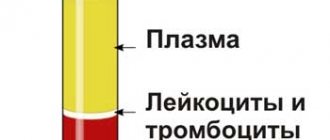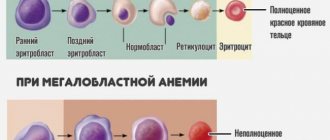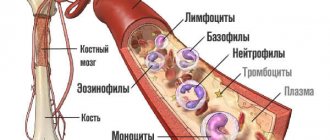Detailed description of the study
ESR (erythrocyte sedimentation rate) is a nonspecific indicator that reflects the presence of any inflammation in the body.
This method is available in all laboratories and is easy to perform, which allows you to quickly assess the patient’s condition and the effectiveness of the treatment.
ESR is an indicator that indicates the rate of separation of blood into upper and lower layers with the obligatory addition of an anticoagulant - a substance that reduces blood clotting. The specific gravity of red blood cells is greater, so due to gravity they end up at the bottom. The top layer contains plasma, and the bottom layer contains red blood cells. The speed is estimated by the height of the appearance of the plasma and is measured in millimeters per hour.
All red blood cells have the same electrical charge on their surface. This property allows them not to stick together in the blood, but to repel each other. When the charge on the membrane changes, they stick together and form so-called “coin columns”.
An increase in ESR is almost always proportional to an increase in the concentration of leukocytes and CRP (C-reactive protein) - other nonspecific markers of inflammation. With increased formation of proteins in the acute phase of inflammation, as well as with changes in the qualitative and quantitative state of red blood cells, a change occurs in the cell membrane, which leads to their gluing and, as a consequence, an increase in ESR.
The process of erythrocyte sedimentation is divided into 3 phases:
- Slow sedimentation in the form of individual cells;
- “Columns” form, and the settling process accelerates;
- Gluing of red blood cells with a gradual cessation of any movement.
The erythrocyte sedimentation rate is a variable value and depends on a large number of factors, both physiological and pathological:
- In women, the ESR is normally slightly higher than in men;
- During pregnancy, ESR is slightly increased due to changes in blood composition, especially protein;
- With anemia - a reduced concentration of red blood cells in the blood) - an acceleration of ESR is observed;
- With an increased concentration of erythrocytes in the body, a slowdown in sedimentation rate is observed;
- During the day, there is a fluctuation in speed and the maximum value can be recorded during the day;
- Newborns have a minimum sedimentation rate, this is due to a high concentration of red blood cells and a small amount of serum proteins;
- A latent inflammatory process that can go away on its own within a few months (extremely rare);
- Oncological and autoimmune diseases;
- For diseases of the thyroid gland: thyrotoxicosis, hypothyroidism;
- Morphological changes in erythrocytes - anisocytosis, spherocytosis, macrocytes - also affect their sedimentation rate.
Erythrocyte sedimentation rate is a nonspecific indicator and can change for various reasons. Therefore, for a complete diagnosis of the condition, it is important to supplement the analysis with a general blood test with leukocyte count and C-reactive protein. To assess the condition, it is important to perform a dynamic analysis, since an increase in ESR is observed a day after the onset of the inflammatory process, and a decrease is a long-term process that can last up to a week.
Assessing the erythrocyte sedimentation rate is important to detect inflammation in the body. In autoimmune diseases, the use of this indicator helps to determine the activity of the disease and evaluate the effectiveness of treatment.
University
→ Home → University → University in the media → Disease or normal? What will the ESR tell you?
A clinical blood test ranks first in the list of mandatory methods for assessing our health and is important for identifying a number of diseases. Despite the fact that the blood of a healthy person strives for constancy in its quantitative and qualitative composition, in everyday practice doctors note certain fluctuations. This also applies to the erythrocyte sedimentation rate (ESR). And although a competent interpretation of a general blood test is within the competence of a doctor, some general understanding of hematological parameters will help, if something happens, to contact a specialist in a timely manner. What is hidden behind the abbreviation “ESR” and should you worry if the result does not coincide with the norm?
The erythrocyte sedimentation rate measures how quickly the blood separates into plasma (the liquid part) and formed elements. If you add an anticoagulant (a substance that prevents clotting) to a vertically mounted test tube, the blood will gradually separate into two layers under the influence of gravity: translucent plasma will be on top, and settled red blood cells will be at the bottom. Thus, ESR is estimated by the height (in millimeters) of the top layer formed within one hour. The normal value of this indicator depends on age, gender and certain physiological conditions of the body (for example, pregnancy, menstruation). In an adult, ESR can fluctuate within a fairly wide range: 0 - 15 mm/h in men and 0 - 20 mm/h in women, which is associated with gender and other differences in the chemical composition of the blood and its level of viscosity. During pregnancy (starting from the 5th week) and in the postpartum period, ESR values increase to 20 - 25 mm/h, and in older people they can reach 30 mm/h and higher. In some cases, an increase in ESR above normal is associated with the presence of bad habits (smoking, addiction to alcohol), the nature of the diet (low-calorie
diet or, conversely, overeating), individual characteristics of the body. Let's say, according to some data, almost 5% of the planet's population has an accelerated erythrocyte sedimentation reaction from birth, but there are no obvious pathological reasons for this. Therefore, if you receive an analysis result with an elevated ESR level, you should first exclude the influence of the factors listed above. Otherwise, too rapid precipitation of red blood cells is a sign of the development of one or even several inflammatory (including infectious) diseases: viral hepatitis, influenza, pneumonia, pyelonephritis, rheumatism, arthritis, etc. After all, inflammatory processes in the human body lead to the accumulation of special protein molecules in the blood that accelerate the reaction of red blood cell adhesion. Other causes of high ESR may include previous trauma or surgery, anemia, pathology of the kidneys or thyroid gland, malignant tumors, or taking certain medications (estrogens, oral contraceptives). A reduced (close to zero) level of ESR is relatively rare and is caused primarily by chronic heart and liver diseases, excess production of red blood cells, treatment with aspirin, prednisolone, etc. In order for the results of the analysis (especially the detailed one) to be reliable, it is advisable to donate blood for research on an empty stomach or at least no earlier than 4 hours after a meal, excluding increased physical activity the day before, stress and anxiety, as well as alcohol consumption. And remember: it is impossible to make a correct diagnosis based only on the ESR indicator - this requires the participation of a specialist doctor and, as a rule, a more in-depth examination. Vladimir KHRYSCHANOVYCH , Doctor of Medical Sciences
Soviet Belarus , November 22, 2018
Share
Important Notes
Material for research Capillary blood.
Children under 7 years of age: venous blood/capillary blood (for special indications). Children over 7 years of age and adults: venous blood. Capillary blood collection for research is carried out only for children under 7 years of age (for special indications)! According to GOST R 53079.4-2008, indications for taking capillary blood are possible: in newborns, in patients with very small or hard-to-reach veins, with large-area burns, and in severely obese patients.
Erythrocyte sedimentation rate
An acute inflammatory response of the body is manifested in the accumulation of acute phase proteins in the blood, such as C-reactive protein, fibrinogen, immunoglobulins, which leads to a change in blood viscosity and affects the ESR (erythrocyte sedimentation rate, ESR) in an upright position. capillary. This is how a laboratory test using Westergren’s method arose in 1921, which he proposed for examining patients with pulmonary tuberculosis. Subsequently, the study of erythrocyte sedimentation rate became a screening laboratory test for the early detection of signs of the inflammatory process.
Determining ESR is informative for identifying diseases accompanied by the accumulation of acute phase proteins in the blood. The test is not specific for any one disease, but is simple to perform. When studying ESR using a standardized method, it is necessary to observe the disposability of using specialized tubes. It is unacceptable to study blood samples taken more than 4 hours ago; this leads to an underestimation of ESR results. Intravenous transfusions of solutions change the ESR value, which must be taken into account when monitoring over time.
When repeating the ESR study in the same hospital (laboratory), the result can be examined over time. If the ESR study is performed in different hospitals, it is difficult for the clinician to interpret the data obtained in different conditions.
To study ESR, a stable room temperature (18–25 °C), disposable cuvette tubes, a stand for strictly vertical execution of the reaction, and a timer clock are required. The sedimentation rate (in mm) of erythrocytes in a graduated test tube over 1 hour is assessed.
It is possible to study ESR in an automated mode, which involves automatically recording the erythrocyte sedimentation time in each tube.
During pregnancy, including the development of anemia, ESR increases with age.
In newborns, the ESR is slow; in adolescence, the ESR corresponds to the values of adults, with no differences in boys and girls.
Upon recovery, ESR returns to the normal range more slowly than the concentration of the marker of the acute phase of the disease - C-reactive protein in the blood.
An increase in ESR occurs in the early stages of myocardial infarction
Indications for the study
- Screening study as part of a general blood test during a preventive examination;
- infectious diseases;
- inflammatory processes;
- malignant neoplasms;
- monitoring the effectiveness of treatment of inflammatory and infectious diseases.
Conditions for collecting and storing the sample.
Whole blood drawn with anticoagulant (EDTA). Blood is drawn on an empty stomach. The blood sample can be stored at 4–8 °C for no more than 24 hours.
Increased values
- Physiological increase in ESR: with age, during pregnancy, during menstruation;
- infectious diseases;
- inflammatory processes;
- inflammatory processes accompanied by necrosis (infarction of various tissues, septic purulent diseases, malignant neoplasms);
- connective tissue diseases and systemic vasculitis (rheumatism, rheumatoid arthritis, systemic lupus erythematosus, periarteritis nodosa, scleroderma, dermatomyositis);
- diseases of the liver parenchyma (hepatitis, cirrhosis, cancer) leading to dysproteinemia, immune inflammation and necrosis of liver tissue;
- metabolic diseases (diabetes mellitus);
- hemoblastoses (leukemia, lymphogranulomatosis);
- paraproteinemic hemoblastoses (myeloma, Waldenström's disease);
- kidney disease (nephrotic syndrome).
Reduced values
- Diseases accompanied by an increase in the number of red blood cells (erythremia, secondary erythrocytosis);
- acidosis (ketoacidosis in diabetes mellitus);
- hyperbilirubinemia;
- starvation, loss of muscle mass;
- taking corticosteroids;
- dehydration;
- myodystrophy.
Inflated figures
Often, after taking tests, the doctor diagnoses an increased ESR.
If there are no symptoms of disease, then after a few days a repeat blood draw may be scheduled, perhaps using a different method to double-check the result. In any case, the doctor has the right to conduct an additional examination, only after which a diagnosis is made. They also pay attention to other indicators; if they are normal, then there is no need to worry. Usually they prescribe a biochemical test of blood, feces and urine, an x-ray or ultrasound, and an ECG. The child himself is also visually examined; importance is attached to the examination of the tonsils and lymph nodes, and external palpation of the internal organs. If it is not possible to combine an increase in ESR with any ailment, then this is considered an individual characteristic of the body.
The erythrocyte sedimentation rate in children is influenced by a variety of factors. As a rule, girls have higher rates than boys. The reason for an elevated ESR may lie if the analysis was taken after eating or taking medications. Therefore, you need to take into account these data, as well as pay attention to the child’s condition. Usually, if there are diseases, their primary signs appear: fever, cough, vomiting.
Basically, high ESR is observed in serious diseases and pathological processes.
These include:
- sore throat, ARVI, influenza, other respiratory diseases;
- inflammation in tissues and organs;
- tuberculosis, pneumonia;
- autoimmune diseases;
- diseases related to the thyroid gland;
- anemia;
- malignant tumors;
- metabolic disease;
- various injuries.
In young children under one year old, an increase in parameters indicates:
- Teething.
- Full-fat breast milk.
- Lack of vitamins.
- Taking antipyretics (paracetamol, ibuprofen).
- Physiological characteristics of the body.
Sometimes the ESR value according to Panchenkov may be slightly higher than normal values, but this will not be a pathology.
Often, elevated ESR in children is not a disease if the child feels healthy and is not capricious.
In this case, the doctor recommends retaking the test after some time to rule out various diseases. False positive erythrocyte sedimentation is often encountered, so this information is also checked when making a diagnosis. In infants, ESR increases if the mother eats fatty foods and also takes paracetamol. Often the cause of this phenomenon is the presence of parasites in the human body; submitting stool for analysis will help rule out this cause.
These include:
- obesity;
- low hemoglobin;
- taking vitamins of group A;
- hepatitis vaccines;
- allergic reactions.
If ESR according to Panchenkov is elevated in children, then additional analysis can be performed using the Westergren method. This method is more accurate, since venous blood is taken. Usually, if the parameters are high, then a repeat blood donation is not required.
Analysis
In all public hospitals, the Panchenkov method is used to determine the ESR value. It is noted that with inflated indicators there are often false results. Therefore, if for a long time (during illness and after recovery) the child’s ESR level is high, then it is recommended to retake the test using the modern Vastergren method.
The erythrocyte sedimentation rate according to Panchenkov allows you to find out whether there is an inflammatory process or any disease in the body. An increased indicator is a reason to do additional research and make a correct diagnosis.
The analysis is taken in the morning before breakfast. It is important that the child does not get nervous or cry before taking the test and behaves calmly. A sample is taken from the finger, then a special Panchenkov tube is placed vertically, having previously added sodium citrate to it to prevent premature blood clotting, and left in this position for 1 hour. Later, the specialist calculates the rate at which the red blood cells separated from the plasma and indicates this on the form . A special feature of this method is that the research is carried out manually. Often laboratory errors can affect the indicator.
Therefore, when testing blood, optimal conditions should be observed: temperature, room humidity and sufficient lighting in the laboratory. Any violation may show a false result.
The Panchenkov and Westergen methods usually show equal indicators, but the values may differ by several units. If the erythrocyte sedimentation rate is too high, then the second method shows higher parameters.
ESR is assessed along with other information, and this is the number of leukocytes, erythrocytes and platelets in the blood. But, despite this, an increased or decreased level is an important sign for diagnosing a disease that has become acute.
There are special standards necessary to evaluate the results:
- In newborns – 2-3 mm/hour.
- In infants from one month to one year - 4-10 mm/h.
- In children from one to eight years old – 4-11 mm/h.
- From 8 to 12 years – 4-12 mm/h.
- In adolescents aged 12 years and older – from three to 15 mm/h.
In this case, the erythrocyte sedimentation value may differ by several units. This is due to the physiological characteristics of each child. According to Panchenkov, when determining ESR, there is no division by gender. Therefore, it is important to evaluate all possible reasons that provoked the increase and monitor the child’s condition. If necessary, repeat the test after a few days in another clinic, or using another method that will give more accurate results.
If the red blood cell level shows 10 mm/h, and the child feels great and there are no signs of illness, then you should not pay attention to this value. An ESR of 15 mm/h may indicate minor pathological processes in the body, so additional examination should be carried out and other data taken into account. If the level differs by 10 units up or down, then the body has inflammatory processes or other serious ailments. An ESR of about 30 indicates an exacerbation of chronic diseases. A dangerous parameter is considered to be the case when the erythrocyte sedimentation rate reaches 40 mm/h. Here it is necessary to immediately identify the source of inflammation and begin appropriate therapy. Higher levels are observed in cancer and blood diseases.







